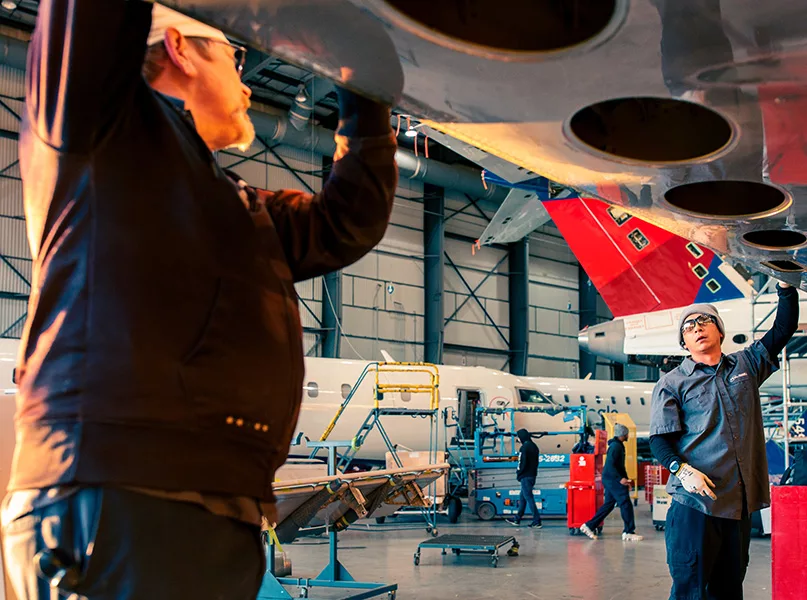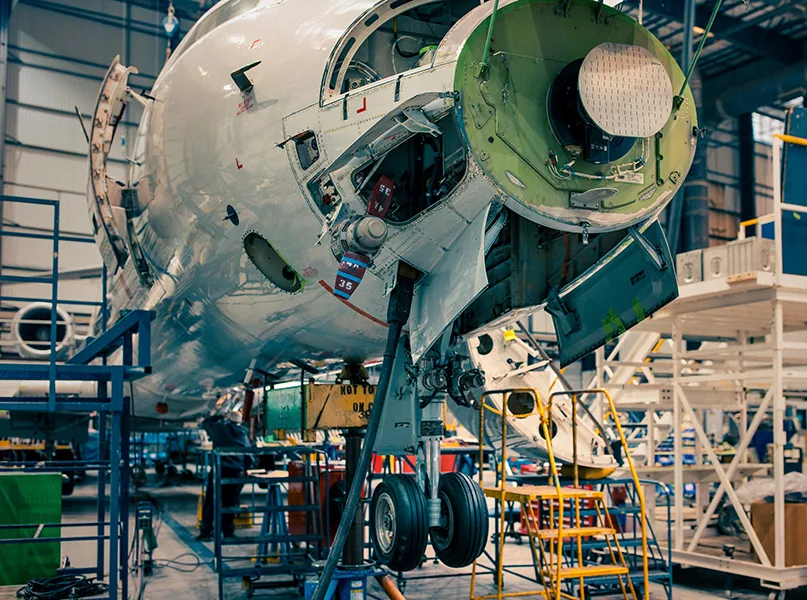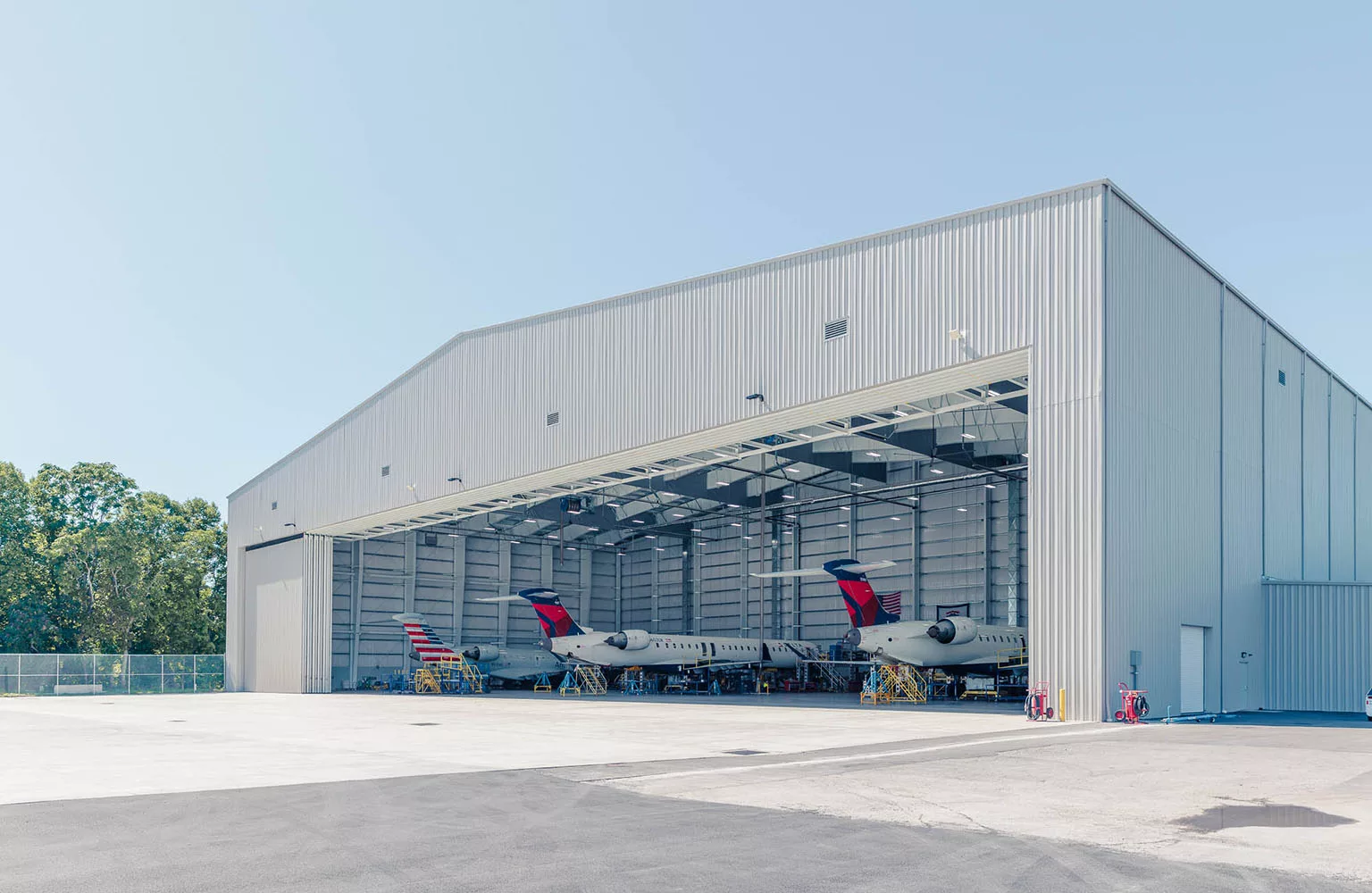As a global leader in aviation, MHI RJ Aviation Group’s world-class services are the building blocks of airline fleets worldwide. We find out more about the company’s driving principles and newest innovations with Vice President, Ross Mitchell.
INNOVATION IN AVIATION
Reliability is the backbone of all aviation industry standards.
Passengers, airlines, manufacturers, and maintenance providers benefit from great teamwork and collaboration, leading to consistent and reliable aircraft service.
This kind of relentless excellence doesn’t go unnoticed, and MHI RJ Aviation Group (MHIRJ) provides comprehensive and critical operational, engineering, and customer support solutions, including maintenance, refurbishment, technical publications, marketing, and sales activities for the global regional aircraft industry.
MHIRJ is a group of companies wholly owned by Mitsubishi Heavy Industries, Ltd. Headquartered in Montréal, Quebec, and bolstered by an Aerospace Engineering Center, MHIRJ’s network of service centers, support offices, and parts depots are positioned in important aviation hubs in the US and Canada.
MHIRJ is the merging of two crucial heritages – Mitsubishi Heavy Industry, Ltd. and the CRJ Series program, which revolutionized regional aviation with the launch of the 50-seat Canadair Regional Jet and was later expanded with the launch of the 70-seat CRJ700 in 1997, the 86-seat CRJ900 in 2000, and the 100-seat CRJ1000 in 2007.

A PLATFORM FOR GROWTH
The CRJ Series has been the world’s most successful regional aircraft family for the last three decades, having made its first flight in 1991.
The jets are known to be reliable, and the strong foundation of the world’s air fleets, connecting people and communities.
On June 1st 2020, MHI acquired the CRJ Series program, marking the opening chapter of MHIRJ’s story. Built on the solid foundations already in place and with the strong support of the MHI group of companies, MHIRJ remains committed to serving the regional aviation market and becoming a platform for growth in the industry.
“The origins of MHI can be traced all the way back to 1884. In that year, Yataro Iwasaki, Founder of Mitsubishi, took a lease out on the government-owned Nagasaki Shipyard. He named it Nagasaki Shipyard & Machinery Works and started the shipbuilding business on a full scale,” explains Ross Mitchell, Vice President of MHIRJ.
“This shipbuilding business was later turned into Mitsubishi Shipbuilding Co., Ltd., and then launched as Mitsubishi Heavy Industries, Ltd. in 1934, establishing its position as the largest private firm in Japan, manufacturing ships, heavy machinery, airplanes, and railroad cars,” he recalls.
Integrating each company’s management and technical expertise and enhancing competitiveness in domestic and international markets, the group has come a long way.
Today, MHIRJ is the type certificate holder for the CRJ Series, meaning that it is responsible for supporting the fleet and can continue the development of the aircraft.
“We provide maintenance and engineering services that keep the fleet flying. If you fly on a CRJ Series aircraft, it is being supported by our team and has more than likely been in one of our maintenance centers.”
Given that the company is no longer manufacturing new aircraft, its focus concerning sustainable aviation is to ensure that the aircraft MHIRJ built continue to fly, thus removing the immediate need to replace them.
“We also work with our customers to ensure any changes that might reduce the fuel burn of the aircraft are considered and, if valuable, implemented. Over the life of the program, we have significantly reduced the fuel burn by making changes to the aircraft systems,” Mitchell divulges.
EVOLVING THE WORKFORCE
The US aviation industry is currently experiencing a period of rapid regrowth following the treacherous fallout of the COVID-19 pandemic.
Meanwhile, the biggest issue in aviation today is the workforce, which widely concerns recruiting pilots, technicians, or other service providers.


“The challenge will be for the industry to explain to younger generations why this is an exciting and dynamic sector to be a part of and why they should consider getting the necessary training,” Mitchell exudes.
Expanding the workforce will require hard work not only from industry but from government and educational institutions as well.
For example, the state of West Virginia recently provided $25 million to build Pierpont College’s new aviation maintenance training facility. Such ambitious and exciting partnerships will allow education institutions to train highly qualified technicians in the sector.
“I began my aviation career about 25 years ago, joining a manufacturer in the contracts department having previously practiced law, and since then, most of my time in aviation has been spent in sales and marketing. I joined MHIRJ almost four years ago and am responsible for strategy, business development, communications, and marketing,” he recollects.
Elsewhere, another challenge that must be tackled is the need for continued support of education and training in the aviation industry. In line with the needs of its sector, MHIRJ recently began offering scholarships to students at an aviation school in Tucson, Arizona (AZ), where one of its service centers is located.
“We’re extremely thankful for the scholarship opportunities that MHIRJ is creating for our students,” said Jason R. Bowersock, Director of Aviation at Pima Community College (PCC).
“For many of our full-time students, pursuing their mechanic’s certificate while working is difficult. Contributions from our generous industry partners help ensure our students’ academic success.”
There is a shortage of talented individuals across all jobs within the sector, and this not only impacts companies like MHIRJ, but whole communities. When there is a shortage of talent, it is the smaller communities that subsequently lose service.
“Governments must work with the aviation industry to ensure that there is a strategy around workforce development to ensure that vulnerable communities are not negatively impacted by the current talent shortage,” states Mitchell.
As workforce recruitment and retention are vital, MHIRJ is currently running a campaign to increase its team to accommodate all the business that it is taking on. The campaign, with the theme “Live your best life”, shows actual employees of MHIRJ to inspire and motivate aviation technicians to join MHIRJ service centers in Tucson, AZ, and Bridgeport, West Virginia (WV).
COMPONENT REPAIR AND OVERHAUL
Driven by an unwavering commitment to world-class customer support, MHIRJ offers a full range of maintenance services around the globe.
One of the greatest success stories for the business in recent years is the development and impressive evolution of its component repair and overhaul (CR&O) capabilities.
“In just two years, we have more than tripled the revenue of that section of the business. That’s a massive expansion, and it shows that when we focus and target a market we want to go after using the infrastructure we have, we can do a good job and quickly gain market share,” Mitchell excites.

“We are now actively looking for ways to expand that business to other CRJ Series systems, and perhaps beyond.”
MHIRJ relies on over 50 years of experience in complex composite and metallic aerostructures to do what is right for its customers. Today, the company offers a broad portfolio of services on engine nacelles, thrust reversers, flight controls, electrical wiring, inlets, exhausts, and door repairs for its supported aircraft types.
Furthermore, MHIRJ’s highly skilled technicians restore its clients’ components to a serviceable standard by providing component inspection, repair and refurbishment, component service bulletin incorporation, non-destructive testing (NDT), warranty services, and full-paint refurbishment offerings.
“Most other companies in the field of maintenance, repair, and overhaul (MRO) or spares distribution do not have the experience level that we have with the fleet of aircraft we service. Our teams designed the aircraft, produced them, and continue to support them in service,” he expresses.
“No other MROs have the depth of experience and the team that we have available for CRJ Series customers.”
As a service company, employees are the key to the success of the business, responsible for MHIRJ’s customer interactions and ensuring its clients remain loyal.
In this way, the company is constantly working on initiatives with its employees to ensure satisfaction is high and that they remain with the business. Attracting new employees, especially now, is difficult and expensive; therefore, the best strategy is to retain valued team members.

When we focus and target a market we want to go after using the infrastructure we have, we can do a good job and quickly gain market share.
Ross Mitchell, Vice President, MHI RJ Aviation Group
This year, MHIRJ is focused on growing its employee population as it continues to experience a surge of business, which brings the need to ensure that the company has the people available and ready to meet demand.
“We will continue to grow and diversify our business, but first, we need to focus on ensuring that we can attract people to MHIRJ before moving too quickly onto our exciting future plans,” Mitchell concludes optimistically.









